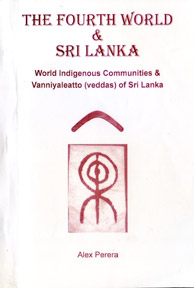Focus on the world’s indigenous people
The Fourth World & Sri Lanka
Author: Alex Perera
An author publication
Reviewed by R.S. Karunaratne
Although we are familiar with the term “Third World”, some of us are
unaware of the “Fourth World.” According to the blurb appearing in the
book, the term “Fourth world” refers to a sub-population subjected to
social exclusion in global society.
 After the publication of The Fourth world: an Indian Reality by
George Manuel in 1974, the term has come to be known as a synonym for
stateless, impoverished and marginalised nations. With the United
Nations Declaration on the Rights of Indigenous People, their
communication and organising among the fourth world people, the term has
gained currency. After the publication of The Fourth world: an Indian Reality by
George Manuel in 1974, the term has come to be known as a synonym for
stateless, impoverished and marginalised nations. With the United
Nations Declaration on the Rights of Indigenous People, their
communication and organising among the fourth world people, the term has
gained currency.
The book is mainly about the world's indigenous communities with
special reference to Veddahs of Sri Lanka, popularly known as
Vanniyaleatto. The first part of the book defines indigenous people and
their rights. The second part deals with Veddahs.
Prof Herath M. Bandara, director, Sabaragamuwa University in his
preface says it is very difficult to define indigenous people and their
identity. The author has discussed indigenous people's rights and their
struggle for freedom and identity.
Traditions
According to the author, there are more than 370 million indigenous
people spread across 70 countries. They have their own traditions,
social, cultural and political characteristics that are unique. He
believes that they are the descendants of those who first inhabited a
particular geographical area. However, those who came to the area later
became dominant as they were militarrily superior to the original
settlers.
Indigenous people in many countries have been identified by different
names. So, we have Lakota in the United States, Mayas in Gautemala,
Saami in northern Europe and Aborigines in Australia. Sri Lanka is home
to Veddahs or Vanniyaleatto. All these people have a problem of
identity. According to the United Nations, the most fruitful approach is
to identify indigenous people rather than trying to define them. The
International Labour Organisation (ILO) has adopted the following
definition to identify them:
“... the social, cultural and economic conditions (of indigenous
people) distinguish them from other sections of the national community
and whose status is regulated wholly or partially by their own customs
or traditions or by special laws or regulations...”
Characteristics
Similarly, the World Bank has identified indigenous people in varying
degrees of certain characteristics. The book provides them in detail.
Apart from definitions, we have to understand indigenous people, their
aspirations and rights. Chapter two has been devoted for this purpose.
Indigenous people are concerned with their legal right to territory they
occupy and their right to use natural resources. They are also proud of
their culture and they like to participate in the country's development
process. Indigenous people also want more autonomy to manage their own
affairs.
Chapter three discusses the distribution of indigenous people in the
world. The author gives a graphic account of their distribution in
countries such as Greenland, Norway, Sweden, Finland, Russia, Canada,
the Unites States, Mexico, Gautamala, Nicaragua, Panama, Colombia,
Suriname, and Sri Lanka.
What does the future hold for the indigenous people across the globe?
The author has discussed the problem in detail in chapter four. He says
that being an indigenous person in modern times means balancing revered
traditions, culture and languages with the demands of a world dominated
by technology.
Robert Knox
Readers will find Robert Knox's 1681 account of the Veddahs quite
interesting. In his account Knox says, “They never cut their hair but
tie it up on their crowns in a bunch. The cloth they use is neither
broad nor large, scarcely enough to cover their buttocks. The wilder and
tamer sort of them do both observe a religion. They have a god peculiar
to themselves. The tamer do build temples, the wild only bring their
sacrifice under trees and whilst offering it dance round it.”
Chapter eight is devoted to Veddahs, the indigenous peoples of Sri
Lanka. Anthropologists believe that Veddahs were identical with Yakkhas
of yore. Sinhala-speaking Veddahs are found primarily in the
south-eastern part of the country.
There are also Sinhala-speaking Veddahs in the Anuradhapura district.
However, Tamil is the primary language of Veddahs found in the Eastern
province. The Veddahs’ cultural activities, burials, cult of the dead,
clothing and livelihood have been explained vividly.
Not only anthropologists but also the general reader has much to gain
by reading The Fourth world and Sri Lanka. |

